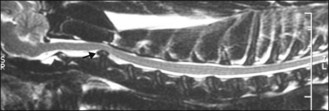69 Neck pain
INITIAL PRESENTATION
Presenting signs may include: low head carriage, not lowering the head to eat from the floor, shaking, trembling, neck spasms which may create a ventral head bob, episodic circling (small radius) and moving the neck and trunk as one unit.
INTRODUCTION
Common causes of neck pain include intervertebral disc disease, meningitis and syringomyelia. All may present acutely. Disc disease is more likely than the others to give rise to ataxia and paresis (see Fig. 69.1). The pain may appear episodic in disc disease and syringomyelia. Meningitis may be multi-focal, and while signs may appear worse on some days compared with others, they are never entirely absent. Haemorrhage into the subarachnoid space causes spinal pain.
DIFFERENTIAL DIAGNOSIS
Young to middle-aged large-to-giant breed male dogs are affected most commonly. Some 18-28% of dogs have multiple areas affected, with the highest incidence in the lumbar region, especially L7–S1, followed by the thoracic and cervical spines. Extension to the vertebral canal and meninges is rare. Discospondylitis has a similar presentation in cats.
Stay updated, free articles. Join our Telegram channel

Full access? Get Clinical Tree



